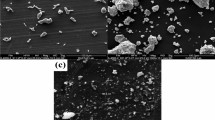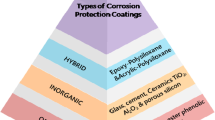Abstract
This work is on the study of the synergetic effect of anodized Al alloy surfaces, with thin tungsten disulphide films alloyed with carbon and fluorine (WS-CF) deposited by magnetron sputtering. The surface roughness and surface chemistry were changed to tune the surface wettability and improve the frictional behaviour of the hybrid surfaces. The SEM analysis of these surfaces showed that, although the film growth has led to the progressive pore narrowing, pores were still visible after deposition of an ~ 200 nm thick film. Even though the film deposition has induced the surface smoothening, the surface free energy (SFE) of the hybrid surfaces was not substantially altered, when compared to bare anodized surface with large dimple (LD). Accordingly, the contact angles measured with water (WCA) and α-bromonaphthalene (OCA) on the hybrid surfaces suggested that the film surface chemistry was the main responsible for the wettability results, having the bottom dimple-shaped surface roughness just a low effect. LD surface coated with pure WS2 coating (LD + WS2) showed a remarkable high hydrophobicity combined with a high oleophilicity. Pin-on-disc testing carried out at room temperature in dry conditions showed much lower coefficient of friction (COF) values for the coated samples (hybrid surfaces), comparatively to uncoated ones. Furthermore, the friction performance of the hybrid surfaces was better for the F-alloyed thin film (sample named as WS-CF5 and having 9.5 at% of F) than for the WS2 film. In lubricated testing with a polyalphaolefin oil (PAO-8), the soft uncoated surfaces presented lower COF values, since the rapid smoothening of the contact surface turned the lubrication regime from mixed to hydrodynamic-like. For the LD surfaces coated with the F-alloyed WS film (named as LD + WS-CF5), the higher hardness of WS-CF5 was responsible for keeping the lubrication regime in partial lubricated conditions, leading to higher initial COF. Afterwards, a WS2-based tribolayer is formed in the solid-solid contacts which, together with the progressive film smoothening, change the lubricated regime toward hydrodynamic. Therefore, the friction of LD + WS-CF5 was reduced with the elapsed time and approached the one of the uncoated samples (LD). Concluding, both these hybrid surfaces can have a role on oil-water separation processes, self-cleaning of building outdoors or on microfluidic and printing applications.










Similar content being viewed by others
References
Cohen SR, Rapoport L, Ponomarev EA, Cohen H, Tsirlina T, Tenne R, Lévy-Clément C (1998) The tribological behavior of type II textured MX2 (M=Mo, W; X=S, Se) films. Thin Solid Films 324:190–197
Polcar T, Cavaleiro A (2011) Self-adaptive low friction coatings based on transition metal dichalcogenides. Thin Solid Films 519:4037–4044
Sorkin V, Pan H, Shi H, Quek SY, Zhang YW (2014) Nanoscale transition metal dichalcogenides: structures, properties, and applications. Crit Rev Solid State Mater Sci 39:319–367
Choi W, Choudhary N, Han GH, Park J, Akinwande D, Lee YH (2017) Recent development of two-dimensional transition metal dichalcogenides and their applications. Mater Today 20:116–130
Lin Z, Carvalho BR, Kahn E, Lv R, Rao R, Terrones H, Pimenta MA, Terrones M (2016) Defect engineering of two-dimensional transition metal dichalcogenides. 2D Materials 3:022002
Polcar T, Evaristo M, Cavaleiro A (2007) The tribological behavior of W–S–C films in pin-on-disk testing at elevated temperature. Vacuum. 81:1439–1442
Pimentel JV, Danek M, Polcar T, Cavaleiro A (2014) Effect of rough surface patterning on the tribology of W–S–C–Cr self-lubricant coatings. Tribol Int 69:77–83
Nossa A, Cavaleiro A (2003) Mechanical behaviour of W–S–N and W–S–C sputtered coatings deposited with a Ti interlayer. Surf Coat Technol 163–164:552
Prasad SV, McDevitt NT, Zabinski JS (2000) Tribology of tungsten disulfide–nanocrystalline zinc oxide adaptive lubricant films from ambient to 500°C. Wear. 237:186–196
Voevodin AA, Zabinski JS (2000) Supertough wear-resistant coatings with ‘chameleon’ surface adaptation. Thin Solid Films 370:223–231
Rodrigues SP, Evaristo M, Carvalho S, Cavaleiro A (2018) Fluorine-carbon doping of WS-based coatings deposited by reactive magnetron sputtering for low friction purposes. Appl Surf Sci 445:575–585
Roberts EW, Price WB (2011) In-vacuo, tribological properties of “high-rate” sputtered MoS2 applied to metal and ceramic substrates. MRS Proc 140:251
Xing Y, Deng J, Zhou Y, Li S (2014) Fabrication and tribological properties of Al2O3/TiC ceramic with nano-textures and WS2/Zr soft-coatings. Surf Coat Technol 258:699–710
Li X, Deng J, Liu L, Zhang L, Sun J, Ge D, Liu Y, Duan R (2018) Tribological properties of WS2 coatings deposited on textured surfaces by electrohydrodynamic atomization. Surf Coat Technol 352:128–143
Roberts EW, Williams BJ, Ogilvy JA (1992) The effect of substrate surface roughness on the friction and wear of sputtered MoS2 films. J Phys D Appl Phys 25:A65–A70
Ji S, Ramadhianti PA, Nguyen TB, Kim WD, Lim H (2013) Simple fabrication approach for superhydrophobic and superoleophobic Al surface. Microelectron Eng 111:404–408
Obikawa T, Kamio A, Takaoka H, Osada A (2011) Micro-texture at the coated tool face for high performance cutting. Int J Mach Tools Manuf 51:966–972
Sousa CT, Leitao DC, Proenca MP, Ventura J, Pereira AM, Araujo JP (2014) Nanoporous alumina as templates for multifunctional applications. Appl Phys Rev 1:031102
Lee W, Park S-J (2014) Porous anodic aluminum oxide: anodization and templated synthesis of functional nanostructures. Chem Rev 114:7487–7556
Rodrigues SP, Alves CFA, Cavaleiro A, Carvalho S (2017) Water and oil wettability of anodized 6016 aluminum alloy surface. Appl Surf Sci 422:430–442
Aerts T, Dimogerontakis T, De Graeve I, Fransaer J, Terryn H (2007) Influence of the anodizing temperature on the porosity and the mechanical properties of the porous anodic oxide film. Surf Coat Technol 201:7310–7317
Guezmil M, Bensalah W, Khalladi A, Elleuch K, Wery M. D.-P and Ayedi H.F (2014) Effect of test parameters on the friction behaviour of anodized aluminium alloy. Int Sch Res Notices., pp. 9.https://doi.org/10.1155/2014/795745
Scaraggi M, Mezzapesa FP, Carbone G, Ancona A, Sorgente D, Lugarà PM (2014) Minimize friction of lubricated laser-microtextured-surfaces by tuning microholes depth. Tribol Int 75:123–127
Shum PW, Zhou ZF, Li KY (2014) To increase the hydrophobicity, non-stickiness and wear resistance of DLC surface by surface texturing using a laser ablation process. Tribol Int 78:1–6
Song X, Huang JZ, Oh S, Danno A, Castagne S (2016) Development of a form rolling micro surface texturing system for friction reduction application in the shaft component. Proc Inst Mech Eng C J Mech Eng Sci 231:4263
Smith AC (1982) The interfacial shear strength of molybdenum disulfide and graphite films. A S L E Transactions 25:349
Polcar T, Evaristo M, Cavaleiro A (2009) Self-lubricating W–S–C nanocomposite coatings. Plasma Process Polym 6:417–424
Polcar T, Evaristo M, Cavaleiro A (2007) Friction of self-lubricating W-S-C sputtered coatings sliding under increasing load. Plasma Process Polym 4:S541–S546
Persson BNJ, Sivebaek IM, Samoilov VN, Zhao K, Volokitin AI, Zhang Z (2008) On the origin of Amonton’s friction law. J Phys Condens Matter 20:395006
Pimentel JV, Polcar T, Evaristo M, Cavaleiro A (2012) Examination of the tribolayer formation of a self-lubricant W–S–C sputtered coating. Tribol Int 47:188–193
Rodrigues SP, Polcar T, Carvalho S, Cavaleiro A (2019) The wettability and tribological behaviour of thin F-doped WS2 films deposited by magnetron sputtering. Surf Coat Technol 378:125033
R. G. S. Hsu. Boundary lubrication and boundary lubricating films; In Modern tribology handbook B. Bhushan, Ed.; CRC Press LLC, 2001, 12, pp. 455
Kalin M, Polajnar M (2013) The correlation between the surface energy, the contact angle and the spreading parameter, and their relevance for the wetting behaviour of DLC with lubricating oils. Tribol Int 66:225–233
Kalin M, Polajnar M (2014) The wetting of steel, DLC coatings, ceramics and polymers with oils and water: the importance and correlations of surface energy, surface tension, contact angle and spreading. Appl Surf Sci 293:97–108
Kannarpady GK, Khedir KR, Ishihara H, Woo J, Oshin OD, Trigwell S, Ryerson C, Biris AS (2011) Controlled growth of self-organized hexagonal arrays of metallic nanorods using template-assisted glancing angle deposition for superhydrophobic applications. ACS Appl Mater Interfaces 3:2332–2340
Santos RJ, Chuvilin A, Modin E, Rodrigues SP, Carvalho S, Vieira MT (2018) Nanoporous thin films obtained by oblique angle deposition of aluminum on porous surfaces. Surf Coat Technol 347:350–357
Govind Rajan A, Sresht V, Pádua AAH, Strano MS, Blankschtein D (2016) Dominance of dispersion interactions and entropy over electrostatics in determining the wettability and friction of two-dimensional MoS2 surfaces. ACS Nano 10:9145–9155
Polcar T, Cavaleiro A (2011) Review on self-lubricant transition metal dichalcogenide nanocomposite coatings alloyed with carbon. Surf Coat Technol 206:686–695
Acknowledgements
This work recognizes the contribution of Prof. Tomas Polcar from the Czech Technical University (CTU), who made his laboratories available to follow the tribological tests.
Funding
This research work was supported through the program COMPETE—Programa Operacional Factores de Competitividade by national funds through FCT—Fundação para a Ciência e a Tecnologia in the framework of the Strategic Funding UID/FIS/04650/2019, UID/EMS/00285/2019 and with a PhD fellowship PD/BD/112079/2015. This work was also sponsored by ATRITO-0 [co-financed via FEDER (PT2020) POCI-01-0145-FEDER-030446 and FCT (PIDDAC)] and On-SURF [co-financed via FEDER (PT2020) POCI-01-0247-FEDER-024521].
Author information
Authors and Affiliations
Corresponding author
Additional information
Publisher’s note
Springer Nature remains neutral with regard to jurisdictional claims in published maps and institutional affiliations.
Rights and permissions
About this article
Cite this article
Rodrigues, S.P., Carvalho, S. & Cavaleiro, A. Tribological performance of hybrid surfaces: dimple-shaped anodized Al alloy surfaces coated with WS-CF sputtered thin films. Int J Adv Manuf Technol 107, 3931–3941 (2020). https://doi.org/10.1007/s00170-020-05326-6
Received:
Accepted:
Published:
Issue Date:
DOI: https://doi.org/10.1007/s00170-020-05326-6




